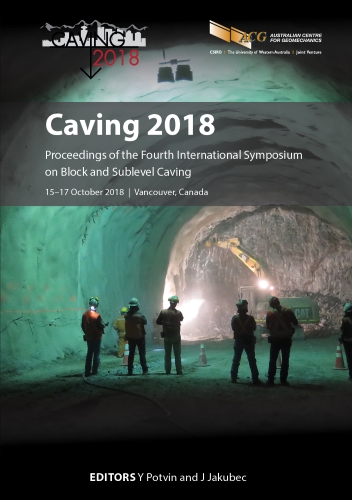Rapid assessment of the spatial extent of strong ground motion in mines – ShakeMap approach

|
Authors: Meyer, S; Doolan, J; Chester, C; Basson, G |
DOI https://doi.org/10.36487/ACG_rep/1815_41_Meyer
Cite As:
Meyer, S, Doolan, J, Chester, C & Basson, G 2018, 'Rapid assessment of the spatial extent of strong ground motion in mines – ShakeMap approach', in Y Potvin & J Jakubec (eds), Caving 2018: Proceedings of the Fourth International Symposium on Block and Sublevel Caving, Australian Centre for Geomechanics, Perth, pp. 533-544, https://doi.org/10.36487/ACG_rep/1815_41_Meyer
Abstract:
Rapid assessment of areas that may experience damage during large seismic events is an important task of seismic monitoring in rockburst-prone mines, particularly in the seconds to hours following the event. Correctly installed sensors of the appropriate type allow instantaneous and accurate measurement at the location of the sensor. However, the ground motion at any point in the mine could be of interest. Traditionally, this assessment at locations away from sensors was estimated using ground motion prediction equations (GMPEs); specially calibrated equations describing the relationship between ground motion, event strength (radiated seismic energy or seismic potency) and distance. However, the uncertainty in these equations is often quite significant due to complexity of the problem, e.g. radiation pattern effects, extended seismic sources, variations in attenuation characteristics, and uncertainty in source parameters. We improve the accuracy of these estimations by combining the measurements at sensors with a GMPE in an approach known as ShakeMap, popular in crustal seismology. This allows for rapid and more accurate estimation of ground motions at any location following a large event. This knowledge can play an important role in planning of potential post-event evacuation operations and damage assessments. The method is demonstrated on examples from an Australian sublevel caving mine.
Keywords: ground motion, ShakeMap, GMPE, seismicity, seismic damage
References:
Aki, K & Richards, PG 2002, Quantitative Seismology, University Science Books, Herndon.
Boore, DM, Gibbs, JF, Joyner, WB, Tinsley, JC & Ponti, DJ 2003, ‘Estimated ground motion from the 1994 Northridge, California, earthquake at the site of interstate 10 and La Cienega Boulevard bridge collapse, West Los Angeles, California’, Bulletin of the Seismological Society of America, vol. 93, no. 6, pp. 2737–2751.
Dunn, MJ 2017, ‘Dynamic ground support – design methodologies and uncertainties’, in J Wesseloo (ed), Proceedings of the Eighth International Conference on Deep and High Stress Mining, Australian Centre for Geomechanics, Perth, pp. 637–650.
Kaiser, PK & Cai, M 2013a, ‘Critical review of design principles for rock support in burst-prone ground – time to rethink!’, in Y Potvin & B Brady (eds), Proceedings of the Seventh International Symposium on Ground Support in Mining and Underground Construction, Australian Centre for Geomechanics, Perth, pp. 3–37.
Kaiser, PK & Cai, M 2013b, ‘Rockburst damage mechanisms and support design principles’, in A Malovhicko & D Malovhicko (eds), Proceedings of the Eighth International Symposium on Rockbursts and Seismicity in Mines, S RAS & MI UB RAS, Obninsk-Perm, pp. 349–370.
Kaiser, PK 2017, ‘Ground control in strainbursting ground – A critical review and path forward on design principles’, in J Vallejos (ed.), Proceedings of the Ninth International Symposium on Rockbursts and Seismicity in Mines, University of Chile, Santiago, pp. 146–158.
Malovichko, D & Meyer, S 2014, Telfer Mine: Analysis of the M2.9 Seismic Event on 7 Nov’14 and Related Seismicity, technical report, Institute of Mine Seismology, Hobart.
McGarr, A 1984, ‘Scaling of ground motion parameters, state of stress, and focal depth’, Journal of Geophysical Research: Solid Earth, vol. 89, no. B8, pp. 6969–6979.
Mendecki, AJ 2013, ‘Frequency range, log E, log P and magnitude’, in A Malovhicko & D Malovhicko (eds), Proceedings of the 8th International Symposium on Rockbursts and Seismicity in Mines, S RAS & MI UB RAS, Obninsk-Perm, pp. 167–173.
Mendecki, AJ 2015, Telfer Mine: Development of Ground Motion Prediction Equation for Telfer Mine Below 4650RL, technical report, Institute of Mine Seismology, Hobart.
Mendecki, AJ 2016, Mine Seismology Reference Book – Seismic Hazard, Institute of Mine Seismology, Hobart.
Newcrest Mining Limited 2014, Seismic Event Investigation 2.7ML event 7-11-2014, Newcrest Internal Report: 700-200-GE-REP-1003, Newcrest Mining Limited, Melbourne.
Ripperger, J, Mai, PM & Ampuero, J-P 2008, ‘Variability of near-field ground motion from dynamic earthquake rupture simulations’, Bulletin of the Seismological Society of America, vol. 98, no. 3, pp. 1207–1228.
van Aswegen, G 2017, ‘Seismic sources and rockburst damage in South Africa and Chile’, in J Vallejos (ed.), Proceedings of the Ninth International Symposium on Rockbursts and Seismicity in Mines, University of Chile, Santiago, pp. 72–86.
Worden, CB, Wald, DJ, Allen, TI, Lin, K, Garcia, D, & Cua, G 2010, ‘A revised ground-motion and intensity interpolation scheme for ShakeMap’, Bulletin of the Seismological Society of America, vol. 100, no. 6, pp. 3083–3096.
© Copyright 2025, Australian Centre for Geomechanics (ACG), The University of Western Australia. All rights reserved.
View copyright/legal information
Please direct any queries or error reports to repository-acg@uwa.edu.au
View copyright/legal information
Please direct any queries or error reports to repository-acg@uwa.edu.au
